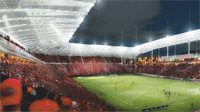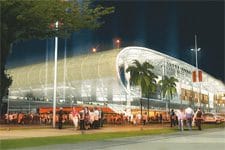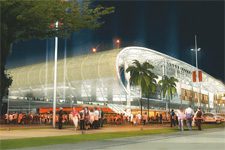That’s it, it’s done. While the soccer world is celebrating awards, Nice football also received its Christmas gift. Senator-Mayor Jacques Peyrat has announced the chosen project for the future Grand Stade de Nice: it will be the one defended by Cari-Spada.
For more than 10 years now, the Grand Stade project in Nice has been on everyone’s lips. When France was awarded the hosting of the 1998 World Cup, it was seriously considered that Nice would be among the organizing cities. However, the city’s financial problems following the “Médecin” affair did not provide it with the means to propose a project that met the organizing committee’s expectations. The project was shelved, but OGC Nice’s return to Ligue 1 changed the game.
A Club in Reconstruction

After considering renovating the Stade du Ray and in a spirit of openness, it was decided to build the stadium in the Plaine du Var, at St-Isidore.
A competition took place between several architectural firms to propose a project that met the demanding specifications of the national football league and the city hall.
Finally, the project defended by the Cari group (lead contractor) with Spada (co-contractor), architects Michel Regembal (one of the architects of the Stade de France), Lucet-Duhamel, Olivier Tampon – Lajariette, the engineering firms Séchaud and Bossuyt and Terrell, and the company Nikaïa, won.
An Ambitious Project

There is also a desire to make this stadium a true daily living space and not just on Saturday nights. To this effect, the stadium premises will include 6,000 m² of office and commercial space, several annex fields, 2,200 parking spaces, and will later include a training center.
Another unique aspect of this project is that the stadium will be energy self-sufficient. It will generate its own electric power, which will be sold to EDF, thanks to 4,000 m² of photovoltaic panels installed on verandas over the parking lots. Solar panels will also provide hot water production. This consortium will also manage the stadium for the next 30 years, similar to what is done with the Stade de France.
Main features of the future stadium:
• 32,826 covered and seated places
• 36 private boxes
• Raised stands: 1.5m
• South Stand all in one piece as per supporters’ request
• Total cost: 90 million Euros, of which 70 million Euros will be borne by the builder
(images source www.lemoniteur-expert.com)



